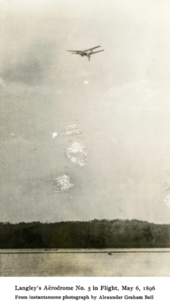Aviation work[edit]
Langley attempted to make a working piloted heavier-than-air aircraft. His models flew, but his two attempts at piloted flight were not successful. Langley began experimenting with rubber-band powered models and gliders in 1887. (According to one book, he was not able to reproduce Alphonse Pénaud's time aloft with rubber power but persisted anyway.) He built a rotating arm (functioning like a wind tunnel) and made larger flying models powered by miniature steam engines. Langley realised that sustained powered flight was possible when he found that a 1 lb. brass plate suspended from the rotating arm by a spring, could be kept aloft by a spring tension of less than 1 oz.
He met the writer Rudyard Kipling around this time, who described one of Langley's experiments in his autobiography:
His first success came on May 6, 1896 when his Number 5 unpiloted model flew nearly 3/4 of a mile after a catapult launch from a boat on the Potomac River.[6] The distance was ten times longer than any previous experiment with a heavier-than-air flying machine,[7] demonstrating that stability and sufficient lift could be achieved in such craft.
On November 11 that year his Number 6 model flew more than 5,000 feet (1,500 m). In 1898, based on the success of his models, Langley received a War Department grant of $50,000 and $20,000 from the Smithsonian to develop a piloted airplane, which he called an "Aerodrome" (coined from Greek words roughly translated as "air runner"). Langley hiredCharles M. Manly (1876–1927) as engineer and test pilot. When Langley received word from his friend Octave Chanute of the Wright brothers' success with their 1902 glider, he attempted to meet the Wrights, but they politely evaded his request.
While the full-scale Aerodrome was being designed and built, the internal combustion engine was contracted out to manufacturer Stephen Balzer (1864–1940). When he failed to produce an engine to the power and weight specifications, Manly finished the design. This engine had far more power than did the engine for the Wright brothers' first airplane—50 hp compared to 12 hp. The engine, mostly the technical work of men other than Langley, was probably the project's main contribution to aviation.[8] The piloted machine had wire-braced tandem wings (one behind the other). It had a Pénaud tail for pitch and yaw control but no roll control, depending instead on the dihedral angle of the wings, as did the models, for maintaining roughly level flight.
In contrast to the Wright brothers' design of a controllable airplane that could fly against a strong wind and land on solid ground, Langley sought safety by practicing in calm air over thePotomac River. This required a catapult for launching. The craft had no landing gear, the plan being to descend into the water after demonstrating flight which if successful would entail a partial, if not total, rebuilding of the machine. Langley gave up the project after two crashes on take-off on October 7 and December 8, 1903.
In the first attempt, Langley said the wing clipped part of the catapult, leading to a plunge into the river "like a handful of mortar," according to one reporter. On the second attempt the craft broke up as it left the catapult (Hallion, 2003; Nalty, 2003).[9] Manly was recovered unhurt from the river both times. Newspapers made great sport of the failures, and some members of Congress strongly criticized the project.
The Aerodrome was modified and flown a few hundred feet by Glenn Curtiss in 1914, as part of his attempt to fight the Wright brothers' patent, and as an effort by the Smithsonian to rescue Langley's aeronautical reputation. Nevertheless, courts upheld the patent. However, the Curtiss flights emboldened the Smithsonian to display the Aerodrome in its museum as "the first man-carrying aeroplane in the history of the world capable of sustained free flight". Fred Howard, extensively documenting the controversy, wrote: "It was a lie pure and simple, but it bore the imprimatur of the venerable Smithsonian and over the years would find its way into magazines, history books, and encyclopedias, much to the annoyance of those familiar with the facts." (Howard, 1987). The Smithsonian's action triggered a decades-long feud with the surviving Wright brother, Orville.
Langley had no effective way of addressing the Wright brothers' central innovation of controlling an airplane too big to be maneuvered by the weight of the pilot's body. So if the Aerodrome had flown stably, as the models did, Manly would have been in considerable danger when the machine descended, uncontrolled, for a landing—especially if it had wandered away from the river and over solid ground.
Air and sea craft, facilities, a unit of solar radiation, and an award have been named in Langley's honor, including:
- Langley Gold Medal by the Smithsonian Institution[10]
- NASA Langley X-43A Hyper-X
- NASA Langley Research Center (NASA LaRC), Hampton, Virginia[11]
- Langley Air Force Base
- Langley Hall at the University of Pittsburgh
- Langley High School in Pittsburgh
- Langley Memorial Aeronautical Laboratory
- Langley unit of solar radiation
- Mount Langley in the Sierra Nevada
- USS Langley (CV-1)
- USS Langley (DE‑131), laid down 10 July 1942 and renamed Hammann on 1 August 1942
- USS Langley (CVL-27)
- Seadrome Langley, intended as one in a chain of Atlantic aviation way-stations, cancelled due to the Depression
- SS Samuel P. Langley, U.S. Liberty Ship




No comments:
Post a Comment